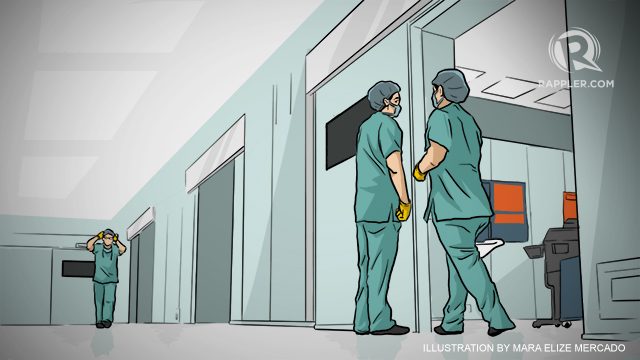SUMMARY
This is AI generated summarization, which may have errors. For context, always refer to the full article.

MANILA, Philippines – Your health and well-being should always be your top priority. Getting proper medical care not only benefits you and your family, but also the country – expert case studies show that a nation-building effort won’t succeed unless proper attention is given to the population’s overall health.
According to the Department of Health’s (DOH) Undersecretary Dr. Kenneth Hartigan-Go, the quality of medical care in the Philippines has evolved significantly.
He explains, “If you look at the way our hospitals are conducting and giving services compared to a decade ago, we have come a long way. Many of our hospitals, in fact, are providing excellent clinical healthcare services.”
These services include doctor consultations, disease and injury treatments, surgeries, hospital confinement, patient education, and preventive advocacy campaigns.
To get the best kind of care, you need to know the basic facts about hospital and clinic standards. Here are a few to keep in mind.
Hospital or clinic?
First, determine whether the facility is a hospital or a clinic. According to the government’s Hospital Licensure Act, a hospital is a 24-hour facility that’s devoted to the diagnosis, treatment, and care of people suffering from illnesses, diseases, or injuries.
A clinic, on the other hand, only deals with people on a limited outpatient basis. However, if a clinic has 6 or more beds or bassinets used for 24-hour care, then it would be considered a hospital, too.
By law, all hospitals are required to provide or sell pharmaceutical products approved by the Food and Drug Administration on-site. These pharmaceuticals must be made available for inpatients and administered to their wards or beds. These medicines must also be accessible to outpatients and the general public.
For outpatient services like basic check-ups and doctor consultations, a clinic will suffice. In case of an emergency, or if you need further treatment, it is best to go to a hospital.
Know the right classification

In the Philippines, hospitals fall under 3 different levels as set out by DOH guidelines.
Level 1 is the most basic. According to Dr. Hartigan-Go, hospitals under this bracket don’t require intensive care units (ICU), and cater to patients who need minor care and supervision.
If there’s a need for a referral, a patient can go to a Level 2 hospital. A Level 2 hospital contains all the elements of Level 1, as well as additional facilities like an ICU for critically ill patients and specialist doctors for gynecology and pediatric services.
If you need a high-level specialty intervention like physical rehabilitation or dialysis treatment, then you go to a Level 3 hospital.
Some hospitals also serve as training facilities for nurses and doctors. Regardless of classification, all hospitals need to have emergency room services.
Quantity and quality of staff

Good facilities should go hand-in-hand with excellent hospital staff.
In government hospitals, the head doctor or Chief of Hospital must have a Master’s Degree in Hospital Administration or a related degree. It’s necessary, Dr. Hartigan-Go says, because hospital management is unique from general operations management. “It’s a different concept. Running a hospital requires serious training because we are talking about saving precious lives, so it is not merely clinical expertise that is needed,” he adds.
In terms of managing workloads, DOH guidelines require 1 staff nurse for every 12 beds on a shift, plus 1 reliever for every 3 nurses. There should also be 1 doctor assigned for every 20 beds.
Beyond academic backgrounds and clinical titles, Dr. Hartigan-Go adds that the ever-evolving nature of medicine means that hospital staff must undergo regular training to keep their skills up-to-date.
“Every 3 years, medical knowledge is estimated to change and there is a turnover of health personnel. In order to keep up, we need to invest in our valued human resources and continuous professional education,” he says.
Observe and discuss

Whatever hospital you choose, the level of care, the quality of the facilities, and the service of the staff should be consistent. For Dr. Hartigan-Go, a patient’s assessment of any hospital should be based on their own observations and experiences, using the basic essentials of medical care and the DOH guidelines as a checklist.
Dr Hartigan-Go says: “Basically, what you expect from a hospital would be what the facility should be doing and providing if you were the patient. You want a clean place. You want efficient customer relations service. You want clarity in terms of where to go and what services are being provided, and the cost. You want friendly, courteous doctors and nurses who explain things well to you and to your family members.”
To help improve our country’s medical care industry, Dr. Hartigan-Go recommends sharing your personal observations and experiences in a public discussion.
With the DOH’s recently launched Hospital Advisor online tool, patients can now locate, review, and interact with the different hospitals and healthcare facilities in the country. The benefit of this platform is that all hospitals can also now promote their services and interact directly with patients to improve their delivery of care.
Like a “Facebook for hospitals,” Dr. Hartigan-Go and the DOH hope that this new tool will empower Filipinos’ discussion on health, and create a collaborative environment for the improvement of health systems and health care providers across the country. – Rappler.com
Add a comment
How does this make you feel?










There are no comments yet. Add your comment to start the conversation.